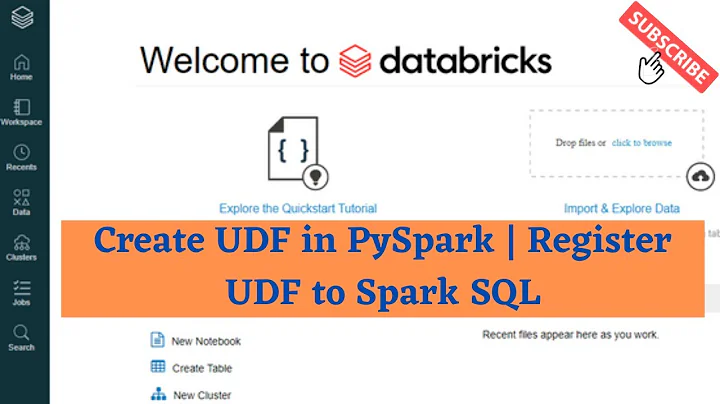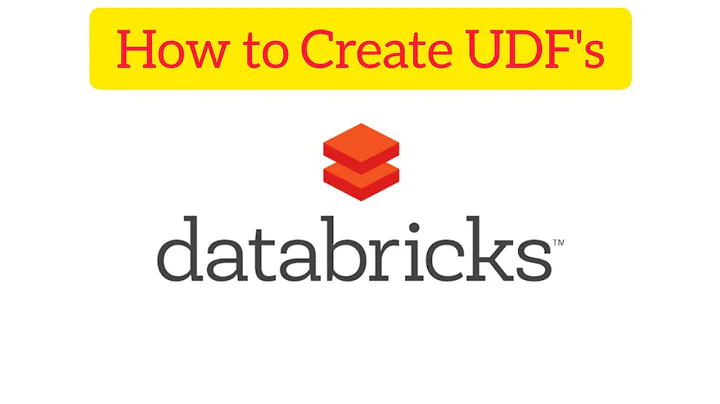Applying UDFs on GroupedData in PySpark (with functioning python example)
Solution 1
Since Spark 2.3 you can use pandas_udf. GROUPED_MAP takes Callable[[pandas.DataFrame], pandas.DataFrame] or in other words a function which maps from Pandas DataFrame of the same shape as the input, to the output DataFrame.
For example if data looks like this:
df = spark.createDataFrame(
[("a", 1, 0), ("a", -1, 42), ("b", 3, -1), ("b", 10, -2)],
("key", "value1", "value2")
)
and you want to compute average value of pairwise min between value1 value2, you have to define output schema:
from pyspark.sql.types import *
schema = StructType([
StructField("key", StringType()),
StructField("avg_min", DoubleType())
])
pandas_udf:
import pandas as pd
from pyspark.sql.functions import pandas_udf
from pyspark.sql.functions import PandasUDFType
@pandas_udf(schema, functionType=PandasUDFType.GROUPED_MAP)
def g(df):
result = pd.DataFrame(df.groupby(df.key).apply(
lambda x: x.loc[:, ["value1", "value2"]].min(axis=1).mean()
))
result.reset_index(inplace=True, drop=False)
return result
and apply it:
df.groupby("key").apply(g).show()
+---+-------+
|key|avg_min|
+---+-------+
| b| -1.5|
| a| -0.5|
+---+-------+
Excluding schema definition and decorator, your current Pandas code can be applied as-is.
Since Spark 2.4.0 there is also GROUPED_AGG variant, which takes Callable[[pandas.Series, ...], T], where T is a primitive scalar:
import numpy as np
@pandas_udf(DoubleType(), functionType=PandasUDFType.GROUPED_AGG)
def f(x, y):
return np.minimum(x, y).mean()
which can be used with standard group_by / agg construct:
df.groupBy("key").agg(f("value1", "value2").alias("avg_min")).show()
+---+-------+
|key|avg_min|
+---+-------+
| b| -1.5|
| a| -0.5|
+---+-------+
Please note that neither GROUPED_MAP nor GROUPPED_AGG pandas_udf behave the same way as UserDefinedAggregateFunction or Aggregator, and it is closer to groupByKey or window functions with unbounded frame. Data is shuffled first, and only after that, UDF is applied.
For optimized execution you should implement Scala UserDefinedAggregateFunction and add Python wrapper.
See also User defined function to be applied to Window in PySpark?
Solution 2
What you are trying to is write a UDAF (User Defined Aggregate Function) as opposed to a UDF (User Defined Function). UDAFs are functions that work on data grouped by a key. Specifically they need to define how to merge multiple values in the group in a single partition, and then how to merge the results across partitions for key. There is currently no way in python to implement a UDAF, they can only be implemented in Scala.
But, you can work around it in Python. You can use collect set to gather your grouped values and then use a regular UDF to do what you want with them. The only caveat is collect_set only works on primitive values, so you will need to encode them down to a string.
from pyspark.sql.types import StringType
from pyspark.sql.functions import col, collect_list, concat_ws, udf
def myFunc(data_list):
for val in data_list:
b, c = data.split(',')
# do something
return <whatever>
myUdf = udf(myFunc, StringType())
df.withColumn('data', concat_ws(',', col('B'), col('C'))) \
.groupBy('A').agg(collect_list('data').alias('data'))
.withColumn('data', myUdf('data'))
Use collect_set if you want deduping. Also, if you have lots of values for some of your keys, this will be slow because all values for a key will need to be collected in a single partition somewhere on your cluster. If your end result is a value you build by combining the values per key in some way (for example summing them) it might be faster to implement it using the RDD aggregateByKey method which lets you build an intermediate value for each key in a partition before shuffling data around.
EDIT: 11/21/2018
Since this answer was written, pyspark added support for UDAF'S using Pandas. There are some nice performance improvements when using the Panda's UDFs and UDAFs over straight python functions with RDDs. Under the hood it vectorizes the columns (batches the values from multiple rows together to optimize processing and compression). Take a look at here for a better explanation or look at user6910411's answer below for an example.
Solution 3
I am going to extend above answer.
So you can implement same logic like pandas.groupby().apply in pyspark using @pandas_udf and which is vectorization method and faster then simple udf.
from pyspark.sql.functions import pandas_udf, PandasUDFType
import pandas as pd
df3 = spark.createDataFrame([('a', 1, 0), ('a', -1, 42), ('b', 3, -1),
('b', 10, -2)], ('key', 'value1', 'value2'))
from pyspark.sql.types import *
schema = StructType([StructField('key', StringType()),
StructField('avg_value1', DoubleType()),
StructField('avg_value2', DoubleType()),
StructField('sum_avg', DoubleType()),
StructField('sub_avg', DoubleType())])
@pandas_udf(schema, functionType=PandasUDFType.GROUPED_MAP)
def g(df):
gr = df['key'].iloc[0]
x = df.value1.mean()
y = df.value2.mean()
w = df.value1.mean() + df.value2.mean()
z = df.value1.mean() - df.value2.mean()
return pd.DataFrame([[gr] + [x] + [y] + [w] + [z]])
df3.groupby('key').apply(g).show()
You will get below result:
+---+----------+----------+-------+-------+
|key|avg_value1|avg_value2|sum_avg|sub_avg|
+---+----------+----------+-------+-------+
| b| 6.5| -1.5| 5.0| 8.0|
| a| 0.0| 21.0| 21.0| -21.0|
+---+----------+----------+-------+-------+
So , You can do more calculation between other fields in grouped data.and add them into dataframe in list format.
Solution 4
Another extend new in PySpark version 3.0.0:
applyInPandas
df = spark.createDataFrame([(1, 1.0), (1, 2.0), (2, 3.0), (2, 5.0), (2, 10.0)],
("id", "v"))
def mean_func(key, pdf):
# key is a tuple of one numpy.int64, which is the value
# of 'id' for the current group
return pd.DataFrame([key + (pdf.v.mean(),)])
df.groupby('id').applyInPandas(mean_func, schema="id long, v double").show()
results in:
+---+---+
| id| v|
+---+---+
| 1|1.5|
| 2|6.0|
+---+---+
for further details see: https://spark.apache.org/docs/latest/api/python/reference/api/pyspark.sql.GroupedData.applyInPandas.html
Related videos on Youtube
arosner09
Updated on December 09, 2021Comments
-
arosner09 over 2 years
I have this python code that runs locally in a pandas dataframe:
df_result = pd.DataFrame(df .groupby('A') .apply(lambda x: myFunction(zip(x.B, x.C), x.name))I would like to run this in PySpark, but having trouble dealing with pyspark.sql.group.GroupedData object.
I've tried the following:
sparkDF .groupby('A') .agg(myFunction(zip('B', 'C'), 'A'))which returns
KeyError: 'A'I presume because 'A' is no longer a column and I can't find the equivalent for x.name.
And then
sparkDF .groupby('A') .map(lambda row: Row(myFunction(zip('B', 'C'), 'A'))) .toDF()but get the following error:
AttributeError: 'GroupedData' object has no attribute 'map'Any suggestions would be really appreciated!
-
Kenny about 5 yearsHow would you simulate panda_udf in Spark<=2.2 (due to company's infra). I would like to parallel process columns, and in each column make use of Spark to parallel process rows. Let's say I have certain stat that I want to apply per column. collect_list gives list, is it efficient to convert to new Spark DF ? def myFunc(d_list): sdf = spark.createDataframe(d_list); return sdf.map(...).reduceByKey(...); and called on two columns df.agg(collect_list('col1').alias('col1'),collect_list('col2').alias('col2') ) .withColumn('col1_', myUdf('col1')).withColumn('col2_', myUdf('col2'))
-
 thentangler about 3 yearsThis doesnt work. I have spark 2.4 and I get
thentangler about 3 yearsThis doesnt work. I have spark 2.4 and I getJob aborted due to stage failure -
 aishik roy chaudhury almost 3 yearsUsing pd inside the function definition of 'g' throws "No module named 'pandas'" error
aishik roy chaudhury almost 3 yearsUsing pd inside the function definition of 'g' throws "No module named 'pandas'" error -
NDS over 2 yearsHow do you modify it for a multi-group by scenario? Let's say there is key1,key2,key3 and value1, value2 - then if I want to do groupby(['key1', 'key2', 'key3']) then how would you modify the apply function?
-
 Mayur Dangar over 2 yearsIt will be same as above , just need to add more keys to groupby method. df3.groupby("key1","key2","key3").apply(g).show()
Mayur Dangar over 2 yearsIt will be same as above , just need to add more keys to groupby method. df3.groupby("key1","key2","key3").apply(g).show()








